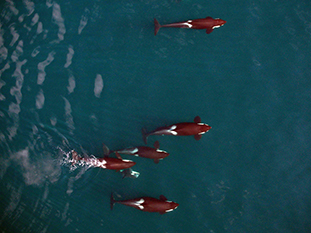If you’re focused on fish, you’re probably more interested in the sea than the sky. But recently more and more fishermen and scientists are sticking their head in the clouds to learn more about the ocean.
We’re talking about drones. While mini-helicopters might make you think of children’s toys, higher quality copters are becoming popular for research.
These photos are helping scientists monitor the health of orca whales. In this photo, you can see that the female at top appears skinny and in poor condition, the female in the middle appears healthy and well-nourished and the whale at bottom is pregnant, her body bulging aft of the rib cage. NMFS photo.NOAA researchers just recently captured some stunning photos of some orca whales in the North Pacific.
"[In] previous attempts to photograph from the air, we’ve been in manned aircraft, like helicopters, so we’ve been a lot higher," NMFS marine mammal biologist John Durban said on a NOAA podcast released last week. "This is the first time we’ve seen this kind of behavior in this kind of clarity.".
Using small, unmanned drones makes it easier to get close to the water. With higher quality photos, scientists can more accurately measure whale growth and health.
A New York Times story on the melting of Greenland’s ice sheet and its potential effects on sea levels featured beautiful stills and video from drones, allowing the reader to get a first-hand look at climate change. Drones didn’t play a hand in research here, but NYT journalists thought their first major drone assignment was successful..
“In this extreme environment, both harsh and stirringly beautiful, the New York Times used a drone to report the assignment, opening a new path for readers to experience our stories. Flying a camera-equipped drone over this terrain resulted from many months of work,” wrote photographer Josh Haner on the experience. “While we cannot yet fly drones in the United States without an FAA exemption and a licensed pilot at the controls, the largely unpopulated country of Greenland proved to be an excellent, if challenging, first drone assignment.”.
The places we can reach using drone technology is amazing. The fact that scientists can now track the location, size and health of certain species almost remotely is an incredible development.
Research aside, some fishermen have been experimenting with using a drone to fish. This angler attached bait and tackle to his quadcopter and actually managed to catch a fish while controlling the drone on land. I doubt one of those personal drones can hold up more than a single fish at a time, so it might not be a good option for your commercial vessel. Who knows though? The uses for this technology seem endless and there are a lot of users experimenting with them right now.
If you don’t have the tools to do serious research and the one-at-a-time fishing method doesn’t work for you, at the very least you can get some great photos and video of the work you do on your vessel and your catch.







